|
|

|
|
Author
|
Topic: Purdue University Library's astronaut collections
|
Robert Pearlman
Editor Posts: 53244
From: Houston, TX
Registered: Nov 1999
|
 posted 11-01-2008 05:56 PM
posted 11-01-2008 05:56 PM
   
collectSPACE First moonwalker Neil Armstrong donates personal papers to PurduePurdue University announced on Saturday that one of their alums will make a donation of his personal papers that will serve as a "launch pad" for their libraries' new comphensive flight-themed collection. Consider it one giant gift by the 'first man,' one small step towards a greater understanding of aerospace history. Gemini and Apollo astronaut Neil Armstrong, who in 1969 became the first person to walk on the Moon, will bestow his personal files, which date back to the beginning of his career, to the Lafayette, Ind. university. |
spaceman1953
Member Posts: 953
From: South Bend, IN
Registered: Apr 2002
|
 posted 11-02-2008 06:15 PM
posted 11-02-2008 06:15 PM
   
Is that cool or what? And just think what a hot bed of research this could become if other astronauts give Purdue University their "stuff"! Centrally located in the nation, the Crossroads of America just keeps getting better all the time! |
John Charles
Member Posts: 342
From: Houston, Texas, USA
Registered: Jun 2004
|
 posted 11-02-2008 10:13 PM
posted 11-02-2008 10:13 PM
  
...Gemini and Apollo astronaut Neil Armstrong, who in 1969 became the first person to walk on the Moon, will bestow his personal files, which date back to the beginning of his career, to the Lafayette, Ind. university. I, for one, would look for the plan Armstrong devised for Deke Slayton to determine "how many crews were needed throughout the entire Gemini program, how many people were needed, with assignments for primary and backup or alternate flight crews..." (Source: "An Interview with Neil A. Armstrong," by Dr. Stephen E. Ambrose and Dr. Douglas Brinkley, NASA Johnson Space Center Oral History Project, September 19, 2001, Houston, Texas. Published in: Quest, vol. 10, no. 1, 2003, pp. 6-45.) |
kr4mula
Member Posts: 642
From: Cinci, OH
Registered: Mar 2006
|
 posted 11-03-2008 12:58 PM
posted 11-03-2008 12:58 PM
   
You caught that, eh? My eyes bugged out when he said that, but alas with Ambrose and Brinkley not being space historians, they breezed right by it. But good luck finding that particular memo in the collection. I imagine it will take some time for everything to get sorted through and any kind of index created. |
Robert Pearlman
Editor Posts: 53244
From: Houston, TX
Registered: Nov 1999
|
 posted 01-15-2009 11:32 PM
posted 01-15-2009 11:32 PM
   
Purdue University release Eugene Cernan, most recent to walk on moon, donating papers to PurdueEugene A. Cernan, the most recent person to walk on the moon, will soon leave another footprint alongside Neil Armstrong, this time in Purdue University Libraries' Archives and Special Collections. Cernan, a 1956 Purdue graduate, is donating his personal papers to the university's flight archives, Purdue President France A. Córdova will announce Friday (Jan 16). Córdova will make the announcement in Houston in an appearance with Cernan. Houston is home to Cernan and to NASA's center for U.S. space flight. "Eugene Cernan set an example of singular achievement for students at Purdue," said Córdova, an astrophysicist and the first woman to serve as NASA's chief scientist. "His legacy is for the world and the ages. We're honored that he has chosen to donate his collections to Purdue and that he continues to remember his alma mater." Cernan's papers will join a growing list of historically significant collections in Purdue Libraries' flight archives. Armstrong, a 1955 Purdue graduate and the first person to walk on the moon, donated personal papers in November. The George Palmer Putnam Collection of Amelia Earhart Papers, the world's largest compilation of papers, memorabilia and artifacts related to the late aviator, also reside there. Earhart, the first woman pilot to cross the Atlantic Ocean, set world aviation records and worked as a Purdue staff member in the mid-1930s. She disappeared July 2, 1937, over the Pacific Ocean as she attempted to fly around the world. Purdue Libraries' Archives and Special Collections also houses the papers of Ralph Johnson, a 1930 Purdue graduate in mechanical engineering and a flight pioneer who was the first person to document aircraft landing procedures that are still used today. "I am extremely proud and honored to be included in the archives of Purdue University with so many people who have contributed so much to our nation," Cernan said. James L. Mullins, dean of Purdue Libraries, said Cernan's papers are a much sought-after addition to the flight archives. "Our expanding flight archives now include some of the key individuals and events in flight history," Mullins said. "These archives also show Purdue's significance in the advancement of flight. We have had 22 Purdue graduates who have gone on to be astronauts, and we want to build our flight archives to reflect the university's rich history and contribution to air travel and space flight." A Chicago native, Cernan graduated from Purdue in 1956 with a bachelor's degree in electrical engineering and was commissioned through the university's ROTC program. He entered flight school after graduating, and in 1963 received a master's degree in aeronautical engineering from the U.S. Naval Postgraduate School. Cernan was one of 14 astronauts selected by NASA in 1963. He carried out three space flights. As a pilot aboard Gemini IX in 1966, he became the second person to walk in space. He was a lunar module pilot for the Apollo X mission in 1969. As commander of Apollo XVII in 1972, he became the most recent person to walk on the moon's surface. Cernan participated in the design, engineering and development testing of spacecraft hardware and systems for NASA. He was a member of NASA's senior management team and reviewed decisions that directly affected operations in mission planning. From 1973-75, he served as a senior U.S. negotiator during discussions with the Soviet Union concerning the joint Apollo/Soyuz project between the two superpowers. After retiring from the Navy in 1976, he joined Coral Petroleum Inc. as executive vice president of the international division. In 1981 he started his own business, the Cernan Corp., to pursue management and consultant interests in energy, aerospace and other industries. He also has been actively involved as co-anchor on ABC-TV's presentations of shuttle flights and on ESPN's documentary coverage of "Earthwinds Hilton." He recently wrote his autobiography "The Last Man on the Moon." Purdue named Cernan a distinguished engineering alumnus in 1967. He holds honorary doctorates from Purdue and three other institutions, along with numerous honors, including the Navy Distinguished Flying Cross, the Distinguished Service Medal with Star and the NASA Distinguished Service Medal. He has been inducted into the U.S. Space Hall of Fame, the National Aviation Hall of Fame, Naval Aviation's Hall of Honor and the International Aerospace Hall of Fame. To date, 22 Purdue alumni have been chosen for space flight. Purdue is known as the "cradle of astronauts," and its alumni have flown on more than one-third of all manned U.S. flights. Córdova will announce Cernan's donation on the second of a six-stop tour visiting Purdue alumni in regions across the United States. The tour began Thursday (Jan. 15) in Dallas and is scheduled to end March 18 in Boston. Other planned stops include Atlanta (Jan. 30), Naples, Fla. (Feb. 14-16), and San Francisco (Feb. 24). Purdue Libraries' Archives and Special Collections moved this week into the state-of-the-art Virginia Kelly Karnes Archives and Special Collections Research Center on the fourth floor of Stewart Center. |
dabolton
Member Posts: 419
From: Seneca, IL, US
Registered: Jan 2009
|
 posted 01-16-2009 09:58 AM
posted 01-16-2009 09:58 AM
  
What about the Cernan Space Center at Triton College? Does it remain open? Granted it is small and dated and should probably be combined with another museum. |
Robert Pearlman
Editor Posts: 53244
From: Houston, TX
Registered: Nov 1999
|
 posted 01-16-2009 10:17 AM
posted 01-16-2009 10:17 AM
   
Based on the schedule presented on their website, the Cernan Earth and Space Center remains open as a planetarium and museum. Triton College named the facility after Cernan "part to honor [his] achievements". |
spaceman1953
Member Posts: 953
From: South Bend, IN
Registered: Apr 2002
|
 posted 01-16-2009 01:43 PM
posted 01-16-2009 01:43 PM
   
Another coup for Purdue! "Come to Indiana and bring your money"! We need it these days! |
Robert Pearlman
Editor Posts: 53244
From: Houston, TX
Registered: Nov 1999
|
 posted 10-30-2009 03:11 PM
posted 10-30-2009 03:11 PM
   
Purdue University release Purdue announces addition of 2 more astronauts' papers to flight collectionPurdue University's flight archives, already steeped with historical artifacts from U.S. space history, is growing thanks to two alumni astronauts. Janice Voss and Roy Bridges Jr. donated personal papers to the Purdue Libraries Division of Archives and Special Collections. The papers will join those of astronaut alumni Neil Armstrong, the first person to walk on the moon, and Eugene Cernan, the most recent person to do so. Purdue President France A. Córvdova announced the addition of the new materials on Wednesday (Oct. 28) in the Virginia Kelly Karnes Archives and Special Collections Research Center. Purdue has 22 astronaut alumni and another who began training in August as an astronaut candidate. "I'm thrilled that two more astronauts have chosen to donate their papers to this university," Córdova said. "Our alumni have taken part in nearly 35 percent of all manned U.S. space flights. They, along with Purdue, have played a defining role in space history. These generous gifts help cement Purdue's place in space and will serve future generations as a historical record and as an inspiration." 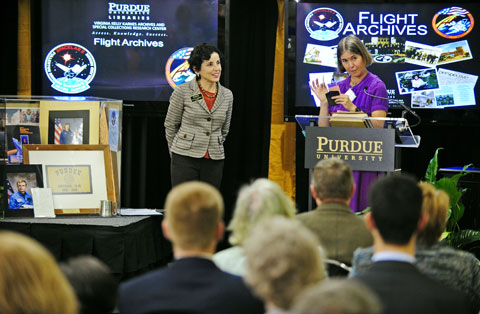 Above: Janice Voss presents NASA security clearance cards to Purdue President France A. Córdova during a reception Wednesday (Oct. 28) in the Virginia Kelly Karnes Archives and Special Collections Research Center. Voss, who was born in South Bend, Ind., and attended high school in Wilbraham, Mass., earned her bachelor's degree in engineering science from Purdue in 1975. She was selected by NASA in 1990 and became an astronaut in 1991. She is a veteran of five space flights, the first of which was aboard the STS57 from June 21 to July 1, 1993. She later was part of space missions in 1995, two in 1997 and the last in 2000. The last mission was an 11-day flight during which the international crew aboard Space Shuttle Endeavour mapped more than 47 million square miles of the Earth's land surface. Voss, who considers Rockford, Ill., her hometown, currently serves as payloads lead of the Astronaut Office Station Branch. She had previously been science director from 2004-07 for NASA's Kepler Space Observatory, launched to discover Earthlike planets orbiting other stars. While on campus, Voss will speak to two sections of a Women in Engineering seminar for first-year engineering students on Thursday (Oct. 29). She has often spoken to women engineering students during visits to campus. "I hope that sharing my personal papers will help motivate the Purdue students following behind me, as taking classes in Grissom Hall did for me," Voss said. "Knowing that someone else got from here to there brightened many of my days at Purdue. Maybe my papers will help someone else feel that they aren't that different from me. If I can do it, then so can they." Bridges who was born in Atlanta and grew up in Gainesville, Ga., earned a master's degree in astronautics from Purdue in 1966. He was selected as an astronaut candidate in 1980 and was the pilot aboard space shuttle Challenger in 1985. The journey was the first pallet-only Spacelab mission and the first to operate the Spacelab Instrument Pointing System. It carried 13 major experiments. Bridges is a retired U.S. Air Force major general. He served from August 2003 to October 2005 as director of NASA's Langley Research Center in Hampton, Va., and before that was director of NASA's John F. Kennedy Space Center for more than six years. He also was commander of the Air Force Flight Test Center, Edwards Air Force Base, Calif.; for the Eastern Space and Missile Center, Patrick Air Force Base, Fla.; and for the 412th Test wing at Edwards. He has received numerous honors, including most recently NASA's Outstanding Leadership Medal and the Presidential Meritorious Award. He is currently an executive with Northrop Grumman Technical Services. 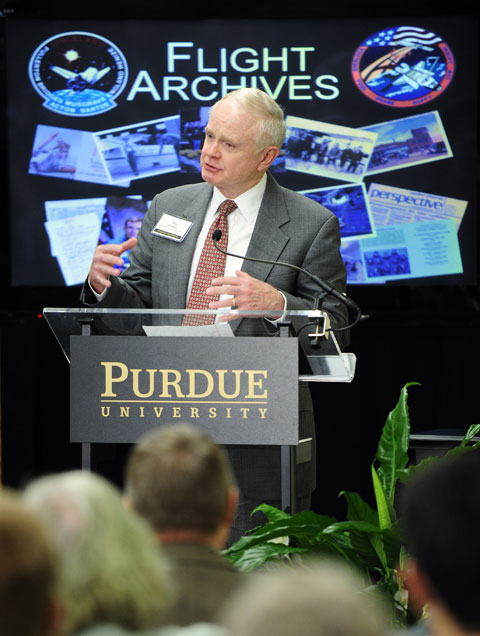
Credit: Purdue University/Andrew Hancock Above: Roy Bridges Jr. talks about his time in space during a reception Wednesday (Oct. 28) in the Virginia Kelly Karnes Archives and Special Collections Research Center. "I was at Purdue a pretty short time, but I've always felt that the university has treated me like I was there for years. So, I've always had a special place in my heart for Purdue," said Bridges, who received an honorary doctorate from Purdue in 2001. "I received a great education at Purdue. It's a great university, and I'm happy to be part of the Purdue family. I hope that my papers will help someone else achieve their goals in life." The addition of the papers from Voss and Bridges will expand a rich and growing collection in Purdue Libraries' Division of Archives and Special Collections. The George Palmer Putnam Collection of Amelia Earhart Papers - the world's largest compilation of papers, memorabilia and artifacts related to the late aviator - along with papers from 1930 graduate and aviation pioneer Ralph Johnson, also are housed there. "We are truly honored to be entrusted with preserving these collections and providing them as documents and artifacts for the historical record," said James L. Mullins, dean of Purdue Libraries. "Purdue's tradition in U.S. air and space travel will live forever in our archives, thanks to our generous alumni." |
Robert Pearlman
Editor Posts: 53244
From: Houston, TX
Registered: Nov 1999
|
 posted 04-08-2011 08:33 PM
posted 04-08-2011 08:33 PM
   
Purdue University release Grant provides archivist to care for Purdue Libraries' astronaut collectionsPurdue Libraries will receive a $2 million grant from the Conrad N. Hilton Foundation to endow an archivist for the Neil Armstrong and Eugene Cernan archives and special collections at the university. Conrad Hilton's son, Barron Hilton, is the retired chairman, president and CEO of Hilton Hotels Corp. An avid pilot and lifelong supporter of aviation, he said that he realizes the special educational and motivational value of these important collections. "As someone who has been personally inspired by Neil Armstrong and Eugene Cernan, I am pleased that their personal papers and artifacts are entrusted to Purdue's professional care," Hilton said. "It is gratifying to know that the careers of these remarkable role models will continue to inspire citizens of the world for generations to come, thanks to Purdue Libraries." Purdue President France A. Córdova said: "We are truly grateful to Mr. Hilton and the Conrad N. Hilton Foundation and honored that they are celebrating Purdue's history of achievement in space through this generous gift. Purdue has a reputation as 'the Cradle of Astronauts,' and we are building flight archives worthy of that reputation. We are thankful that Mr. Hilton will help provide us with this great resource to be able to reach flight enthusiasts and researchers around the world with our collection." Purdue Libraries' division of Archives and Special Collections is home to the papers and artifacts of some of the most recognizable names in U.S. flight history. Armstrong, the first person to walk on the moon, and Cernan, the most recent person to do so, donated papers. Astronauts Janice Voss and Roy Bridges Jr. followed in donating personal collections. The George Palmer Putnam Collection of Amelia Earhart Papers - the world's largest compilation of papers, memorabilia and artifacts related to the late aviator - along with papers from 1930 graduate and aviation pioneer Ralph Johnson, also are housed there. "This endowed position will give us the ability to devote someone full time to building upon our tremendous collection of Purdue flight history," said James L. Mullins, Purdue Libraries dean. "This process of making Purdue Archives and Special Collections a destination for those wanting a true sense of U.S. flight history is going to grow, thanks to Mr. Hilton and the Conrad N. Hilton Foundation." |
Robert Pearlman
Editor Posts: 53244
From: Houston, TX
Registered: Nov 1999
|
 posted 02-07-2013 11:01 AM
posted 02-07-2013 11:01 AM
   
Purdue University release Jerry Ross becomes latest alumni astronaut to donate papers to PurduePurdue University's already rich collection of papers, artifacts and memorabilia from pioneering aviators and iconic space travelers is growing. The university announced Thursday (Feb. 7) during an invitation-only ceremony in the Virginia Kelly Karnes Archives and Special Collections Research Center that astronaut alumnus Jerry Ross is donating his papers. His donation includes artifacts from his time as a Purdue student, including his research thesis; photographs; test pilot manuals and flight checklists from work on the B-1 aircraft at Edwards Air Force Base; and documents and artifacts from his long NASA career. "The collection includes documents and artifacts that provide insight into Jerry's Indiana childhood, his education and student life at Purdue, and his career as an Air Force engineer and NASA astronaut," said Tracy Grimm, the Barron Hilton Archivist for Flight and Space Exploration in Purdue Libraries Division of Archives and Special Collections. "Jerry was one of the few astronauts with NASA before the first Shuttle launch through the last Shuttle touchdown in 2011, and his papers can provide a window through which students and scholars may begin to understand and take measure of the era of the U.S. Space Shuttle program." Ross was an Air Force ROTC student at Purdue from Crown Point, Ind., who received his undergraduate degree in 1970 and master's degree in mechanical engineering in 1972 from the university. He was a NASA astronaut from 1980 until his retirement in January 2012. Ross is one of only three astronauts to serve throughout the entire Space Shuttle program. He holds the world record for the number of launches at seven with one other person and ranks third in the world for his nine spacewalks. He was among the first astronauts to enter the International Space Station in orbit; played a key role in recovering pieces of the Columbia Shuttle after its tragic accident; and helped develop facilities, tools and techniques that continue to be used in space today. Ross' collection includes mission manuals, checklists, reports, original 16-mm films and videos taken before, during and after Shuttle launches, his blue NASA flight suit, patches, test pilot school flight helmet and several awards and plaques. "First, I'm very pleased that Purdue has established a new segment of their archives that is allowing people to be able to research and see the history of flight," Ross said. "Beyond that, I'm honored and delighted to have the opportunity be able to place a very large collection with Purdue. It has a lot of memories for me and a lot of historical value. I hope future generations have the opportunity to come and look at these artifacts to get a sense of our flight history. I've been through the Purdue archives and collections, and it's very impressive." His donation adds to a Purdue Libraries archives collection that includes some of the most iconic names in flight and space travel. Alumni astronauts Neil Armstrong, the first person to walk on the moon, and Eugene Cernan, the most recent to do so, have donated papers, as have Roy Bridges Jr. and the late Janice Voss. The preservation and cataloging of the collections is supported with funding from Barron Hilton and the Conrad N. Hilton Foundation. The flight archives also house the George Palmer Putnam Collection of Amelia Earhart Papers, the world's largest compilation of papers, memorabilia and artifacts related to the late aviator, and papers from 1930 graduate and aviation pioneer Ralph Johnson. "Purdue University is extremely fortunate to have 23 alumni astronauts, and we are honored that Jerry is entrusting our Division of Archives and Special Collections with the preservation of documents and artifacts," Purdue Libraries Dean James L. Mullins said. "We are privileged to be able to build on our collection of historical records befitting a university called 'the Cradle of Astronauts.'" |
Robert Pearlman
Editor Posts: 53244
From: Houston, TX
Registered: Nov 1999
|
 posted 04-11-2014 11:08 AM
posted 04-11-2014 11:08 AM
   
Purdue University release Alumni astronaut Cernan donates mapbook from Apollo 17 lunar missionEugene Cernan, the most recent person to walk on the moon, was recognized on Thursday evening (April 10) during an invitation-only reception at Purdue's Mackey Arena for donating an Apollo 17 Lunar Roving Vehicle mapbook to the university. Cernan, a 1956 Purdue graduate, donated his personal papers to the Barron Hilton Flight and Space Exploration Archives in January 2009. He followed up with the donation of the Apollo 17 mapbook this past December (Thursday's event served as the public announcement). 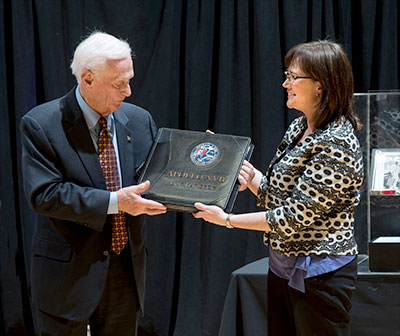 Above: Astronaut Eugene Cernan presents the lunar mapbook used on the Apollo 17 space flight to Tracy Grimm, the Barron Hilton Flight and Space Exploration archivist for Purdue University Libraries' Division of Archives and Special Collections. Credit: Purdue/Mark Simons The maps are mounted in a custom-made book and are accompanied by several contextual documents and photographs. The maps provided the crew with bearings and ranges to each investigation site on the lunar surface during more than 22 hours of exploration. The Barron Hilton Flight and Space Exploration Archives was established with gifts from Barron Hilton and the Conrad Hilton Foundation. It is part of the Purdue Libraries' Virginia Kelly Karnes Archives and Special Collections Research Center. In addition to being home to the largest collection of Amelia Earhart papers in the world, the archives include the papers of engineers, aviators, aviation professionals, scholars and alumni astronauts including Neil A. Armstrong and Cernan - the first and last persons to walk on the moon - Jerry Ross, the late Janice Voss and Roy Bridges Jr. |
Robert Pearlman
Editor Posts: 53244
From: Houston, TX
Registered: Nov 1999
|
 posted 11-21-2014 03:26 PM
posted 11-21-2014 03:26 PM
   
Purdue University release Purdue Libraries celebrates gift of Armstrong papersPurdue University on Friday (Nov. 21) recognized Carol Armstrong for the gift of papers valued at more than $3.4 million from her late husband, Neil A. Armstrong, a 1955 Purdue graduate and the first person to step on the moon. Carol Armstrong, along with alumnus astronaut Gene A. Cernan, the most recent person to walk on the moon, attended a private event honoring the gifts at the Purdue Libraries' Virginia Kelly Karnes Archives and Special Collections Research Center. "Neil Armstrong epitomized in a very literal sense just how far an education could take a person. He came to Purdue with natural talent and a dream, and through hard work and a strong code of personal value, became an American icon," said Purdue President Mitch Daniels. "Only a few achieve such status. But he is an example to all young people to dare to dream. "We're truly grateful that his wife, Carol, chose to further honor his legacy and Purdue with these gifts. And it is fitting that Gene Cernan, another example of a Purdue Boilermaker who imagined the possibilities, is here to share in this special occasion. Neil and Gene are forever linked as Purdue alumni and the first and – for now – last people to walk on the moon." Neil Armstrong, a 1955 Purdue graduate, began donating personal papers to the Purdue Libraries' Division of Archives and Special Collections in 2008 after carefully considering repository options, said Sammie Morris, head of the Archives and Special Collections Division and associate professor. "Neil carefully interviewed us to be sure the papers would not sit in storage, but rather be made available for scholarly research and access to students," Morris said. While Armstrong donated a portion of his artifacts and papers before his death in 2012, Carol has since given the bulk to Purdue Libraries per his wishes. The papers span Armstrong's lifetime and have undergone archival processing. The collection is now part of the Barron Hilton Flight and Space Exploration Archives and is open for scholarly research. In celebration, the Division of Archives and Special Collections has mounted the exhibit "Steps to the Moon: Selections from the Neil A. Armstrong Papers and the Eugene C. Cernan Papers." The exhibit in the Karnes Research Center, which is on the fourth floor of the Humanities, Social Science and Education Library in Stewart Center, will be on display through Feb. 27. Open house events featuring the exhibit for parents and children are scheduled for Dec. 6 and Jan. 17 from 1-3:30 p.m. both days. Visitors will be able to tour the exhibit and participate in a space facts scavenger hunt. Parking in the Grant Street and Marstellar Street parking garages is free on Saturday. Armstrong's papers include items from grade school, his participation in the Boy Scouts of America, his college years and NASA career. Documents from his work on various commissions and boards, as well as hundreds of speaking engagements, also are included. The papers include approximately 70,000 pages of fan mail, the bulk of which Armstrong received in the months and years following the moon landing, Grimm said. "Expressions of awe and the global reaction to the first human to walk on the moon are vividly represented in the fan mail, which often included personal photographs, drawings, poems and musical compositions in addition to notes of congratulations and gratitude," she said. The papers also include Armstrong's extensive subject files, photographs, prepared speeches, awards, news clippings, and commemorative artwork and memorabilia. The materials span his test pilot work at Edwards Air Force Base through his Apollo 11 command and his final NASA assignment as deputy administrator of aeronautics. "They highlight his contributions as an engineer to the developing U.S. space program," Grimm said. "Much like the Eugene Cernan papers and those we hold of other astronauts and engineers, the papers reflect the unique perspective of an individual who played one of many key roles in the space program during an exceptional period in its history." The Hilton Flight Archives also holds the George Palmer Putnam Collection of Amelia Earhart Papers and the Eugene A. Cernan Papers, as well as those of other aviators, engineers and astronauts. The Hilton Flight Archives was established in 2011 with a grant from the Conrad N. Hilton Foundation to endow an archivist for flight and space with particular attention to the Neil Armstrong and the Eugene Cernan papers. Cernan, a 1956 Purdue graduate, served as pilot for the 1966 Gemini 9 spacecraft, lunar module pilot for Apollo 10 and commander for Apollo 17. "The support and generosity of Neil and Carol Armstrong and Eugene Cernan were key to the establishment of the endowment for the Flight and Space Archives and to the ongoing growth of the Flight Archives," said Purdue Libraries Dean James L. Mullins. "Engineers, former test pilots and astronauts, and administrators have placed their papers in the Hilton Flight Archives in no small part because Neil and Gene have done so. We've been entrusted also because of the tremendous support for the established endowment and the high priority the university places on the preservation of these unique records of human achievement." |
KSCartist
Member Posts: 3095
From: Titusville, FL
Registered: Feb 2005
|
 posted 11-21-2014 04:09 PM
posted 11-21-2014 04:09 PM
   
I gifted Neil Armstrong with my X-15, Gemini and Apollo Commemorative patches in 2009 and received an email from him thanking me. I wonder if they were included in the Purdue donation. |
Robert Pearlman
Editor Posts: 53244
From: Houston, TX
Registered: Nov 1999
|
 posted 01-28-2019 12:29 PM
posted 01-28-2019 12:29 PM
   
Purdue University release Apollo 11 in the Archives: Selections from the Neil A. Armstrong Papers ExhibitJuly 20, 2019, marks the 50th anniversary of the first manned spaceflight that landed on the moon. To commemorate Purdue alumnus Neil A. Armstrong's and humanity's first step on the lunar surface, the Purdue Archives and Special Collections presents "Apollo 11 in the Archives: Selections from the Neil A. Armstrong Papers." The exhibit opens Monday, March 18 and runs through Friday, August 16, 2019 and is free and open to the public. Contact Purdue Archives and Special Collections for hours at (765) 494-2839.
Armstrong's papers are a collection in the Barron Hilton Flight and Space Exploration Archives in the Purdue Archives and Special Collections, a division of Purdue University Libraries. |
Robert Pearlman
Editor Posts: 53244
From: Houston, TX
Registered: Nov 1999
|
 posted 03-19-2019 12:30 AM
posted 03-19-2019 12:30 AM
   
collectSPACE 'Apollo in the Archives' exhibit offers look at Neil Armstrong papersAn exhibition at Neil Armstrong's alma mater is offering the public a new look at the student and man who became the first moonwalker. "Apollo in the Archives: Selections from the Neil A. Armstrong Papers" opened on Monday (March 18) at Purdue University in West Lafayette, Indiana. The exhibit, which is timed to coincide with the 50th anniversary of Armstrong's Apollo 11 moon landing in July, showcases select documents and objects from the school's research holdings. 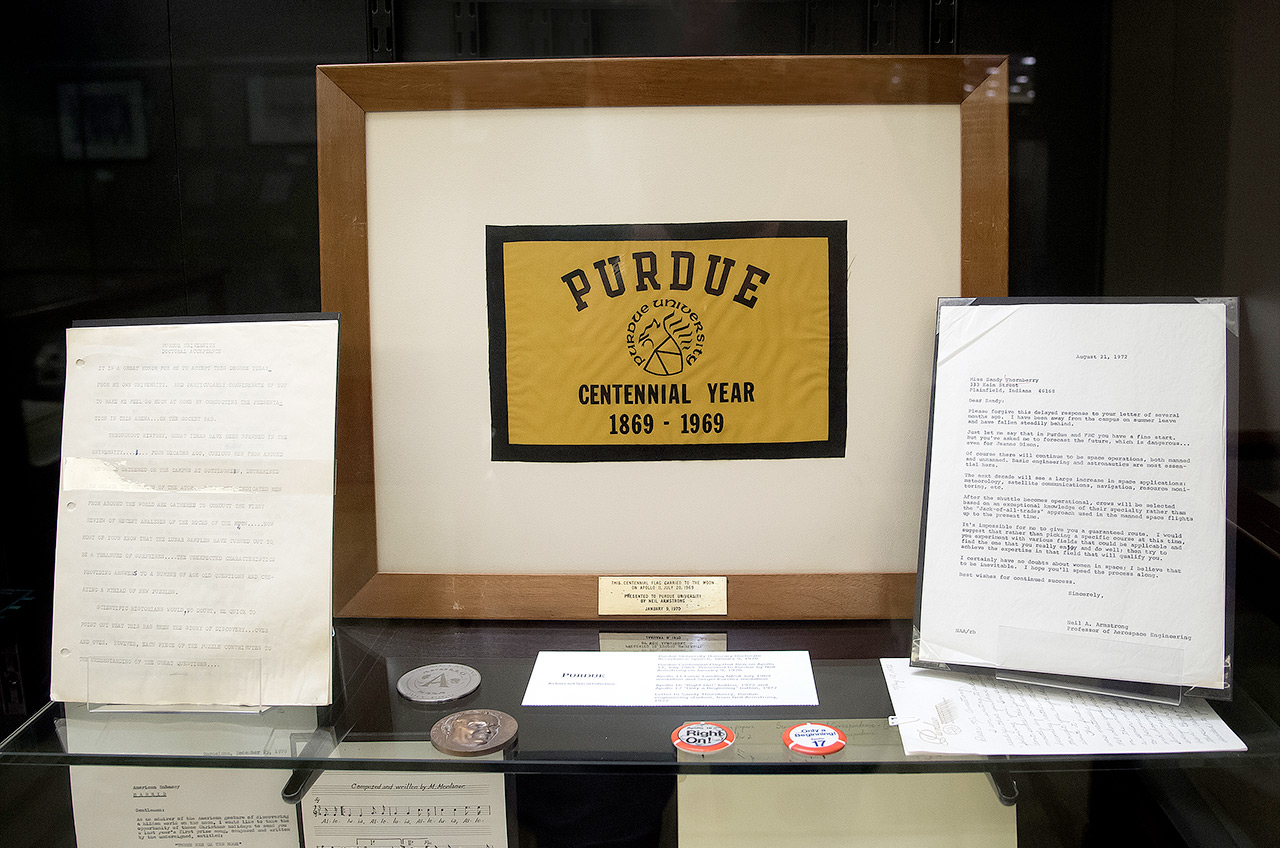 |
Robert Pearlman
Editor Posts: 53244
From: Houston, TX
Registered: Nov 1999
|
 posted 05-30-2019 03:52 PM
posted 05-30-2019 03:52 PM
   
Purdue University release Wright Flyer fabric lands at Purdue University ArchivesTwo monumental events in the history of flight and space - the Wright Brothers' first power-controlled flight and Neil Armstrong's first steps on the moon - have a unique connection that is now represented in the Barron Hilton Flight and Space Exploration Archives and currently on display at Purdue University's Archives and Special Collections. 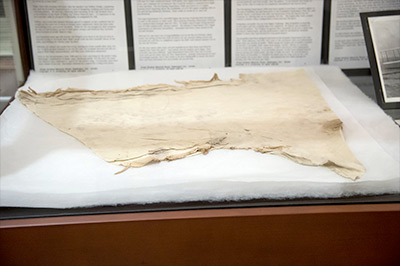 Above: Neil Armstrong’s widow, Carol Armstrong, recently donated two pieces of fabric from the wings of the original 1903 Wright Flyer flown at Kitty Hawk. Neil Armstrong's widow, Carol Armstrong, recently donated two pieces of fabric from the wings of the original Wright Brothers Flyer, built in 1903 and flown at Kitty Hawk. This donation to Purdue bridges these two pivotal flight and space events, connecting the Purdue family all the way back to the birth of aviation by powered flight. Purdue's Archives and Special Collections announced the gift of the fabric pieces, each measuring approximately 25 inches by 24 inches, at a private reception last month. The pieces are particularly important because they were given to Neil Armstrong to take with him on the Apollo 11 mission aboard his historic landing of the Eagle lunar module on the moon. Along with the fabric, Armstrong donated related correspondence from 1969 between the Air Force Museum and Neil Armstrong regarding the Wright Flyer fabric. One of the pieces is now on display in the "Apollo in the Archives: Selections from the Neil A. Armstrong Papers" exhibit through Aug. 16. Tracy Grimm, the Barron Hilton archivist for Flight and Space Exploration and associate head of Archives and Special Collections, said the gift bridges the history of flight and space. "To know that these pieces of fabric connect the first human steps on the lunar surface with the first powered, heavier-than-air machine sustained flight is astonishing," Grimm said. "To think that Orville and Wilbur Wright and Neil Armstrong all touched and held this fabric is incredible. It shows that Neil honored the pioneers who came before him, just as we honor his accomplishments." Purdue's ownership of the Armstrong Papers, a collection of more than 450 boxes of Armstrong's manuscripts, personal papers, and working files, alongside this recent addition of the Wright Brothers Flyer fabric, are all due to the generosity of Neil and Carol Armstrong. Armstrong began giving his papers to Purdue, his alma mater, during his lifetime and Carol continued to donate items over time. Armstrong donated the papers to support Purdue's teaching and learning goals and to advance scholarship. The papers are accessible by appointment to faculty, students, and scholars conducting scholarly research. Sammie L. Morris, professor and head of archives and special collections, said the donation continues to help bring flight and space history to life. "As we celebrate the 50th anniversary of the Apollo 11 mission this year, we show how Purdue has helped the world advance in transportation and exploration. It is so fitting that the 50th anniversary of Apollo 11 coincides with Purdue's 150th birthday this year, cementing forever the close relationship Purdue has had to flight and space history from its beginnings," Morris said. |
Robert Pearlman
Editor Posts: 53244
From: Houston, TX
Registered: Nov 1999
|
 posted 10-02-2024 12:45 PM
posted 10-02-2024 12:45 PM
   
collectSPACE First moonwalker Neil Armstrong's speech notes posted online by PurdueApollo 11 astronaut Neil Armstrong is perhaps best known for saying 11 words on July 20, 1969 (12, if you count the "a"): "That's one small step for (a) man, one giant leap for mankind." But there is much, much more to his oral record, as his alma mater can now confirm — and everyone can access. The Archives and Special Collections (ASC) division of Purdue University Libraries in West Lafayette, Indiana, has completed scanning the transcripts used by the first moonwalker for his public addresses and some of his speeches. The 7,700 pages, which were donated in 2011 by Armstrong's wife Carol, can now be freely accessed using the school's online archives platform. 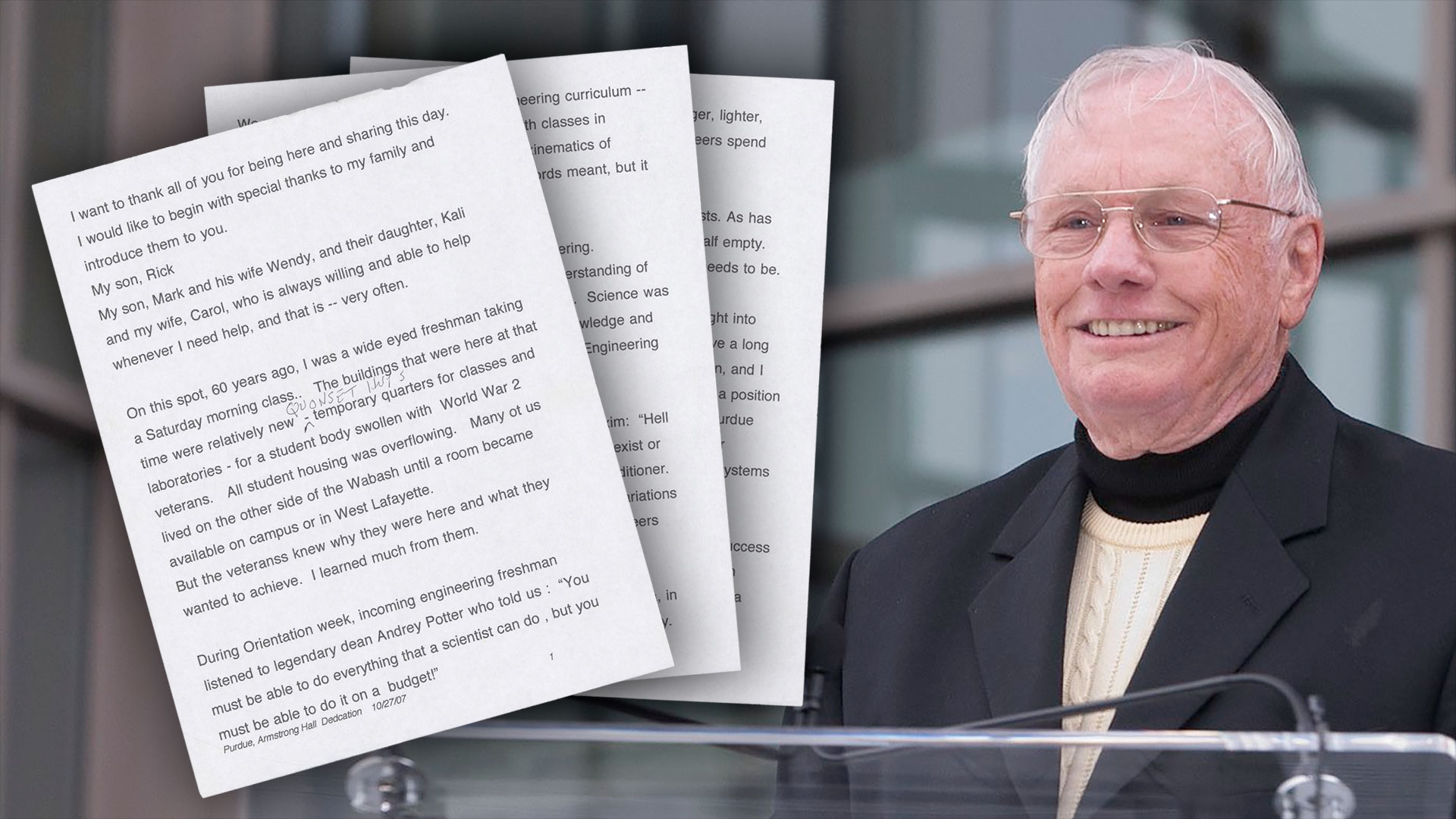 |
ejectr
Member Posts: 2022
From: Killingly, CT
Registered: Mar 2002
|
 posted 10-03-2024 09:47 AM
posted 10-03-2024 09:47 AM
   
Sent this to my son, who is a Purdue graduate of their Aeronautics and Astronautics degree. He will enjoy this... | |
Contact Us | The Source for Space History & Artifacts
Copyright 1999-2024 collectSPACE. All rights reserved.

Ultimate Bulletin Board 5.47a
|
|

|
 advertisement advertisement

|

















